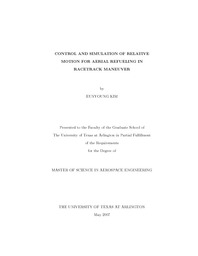
ATTENTION: The works hosted here are being migrated to a new repository that will consolidate resources, improve discoverability, and better show UTA's research impact on the global community. We will update authors as the migration progresses. Please see MavMatrix for more information.
Show simple item record
| dc.contributor.author | Kim, Eunyoung | en_US |
| dc.date.accessioned | 2007-08-23T01:56:27Z | |
| dc.date.available | 2007-08-23T01:56:27Z | |
| dc.date.issued | 2007-08-23T01:56:27Z | |
| dc.date.submitted | May 2007 | en_US |
| dc.identifier.other | DISS-1720 | en_US |
| dc.identifier.uri | http://hdl.handle.net/10106/304 | |
| dc.description.abstract | This thesis addresses the problem of controlling the receiver aircraft to achieve a successful aerial refueling. For the performance verification of the controller, a new set of nonlinear, 6-DOF, rigid body equations of motion for the receiver aircraft has been used. The equations are written in terms of state variables that are relative to the reference frame that is attached to, translates and rotates with the tanker aircraft. Furthermore, the nonlinear equations contain the wind effect terms and their time derivatives to represent the aerodynamic coupling involved between the two aircraft. These wind terms are obtained using an averaging technique that computes the effective induced wind components and wind gradients in the receiver aircraft's body frame. Dynamics of the engine and the actuators are also included in the study. A position-tracking controller has been designed using ''gain scheduling'' technique based on a combination of integral control and optimal LQR design. The scheduling is utilized to satisfy the performance requirement of the controller during the whole ''racetrack'' maneuver of the tanker in a standard aerial refueling operation. The nominal flight conditions that are used for the linearization of the nonlinear equations of motion are (i) straight wing-level flight and (ii) steady turn. The position tracking controller can be used for (i) flying from observation position to the refueling position, (ii) station keeping for the actual fuel transfer during the whole racetrack maneuver of the tanker and (iii) flying away from the refueling position once the fuel transfer is completed. The performance of the controller is evaluated in a high fidelity simulation environment, which, employing the new sets of equations of motion, includes the relative motion of the receiver and the tanker and the aerodynamic coupling due to the trailing vortex of the tanker. The simulation and control design are applied to a tailless fighter aircraft with innovative control effectors and thrust vectoring capability. | en_US |
| dc.description.sponsorship | Dogan, Atilla | en_US |
| dc.language.iso | EN | en_US |
| dc.publisher | Aerospace Engineering | en_US |
| dc.title | Control And Simulation Of Relative Motion For Aerial Refueling In Racetrack Maneuver | en_US |
| dc.type | M.S. | en_US |
| dc.contributor.committeeChair | Dogan, Atilla | en_US |
| dc.degree.department | Aerospace Engineering | en_US |
| dc.degree.discipline | Aerospace Engineering | en_US |
| dc.degree.grantor | University of Texas at Arlington | en_US |
| dc.degree.level | masters | en_US |
| dc.degree.name | M.S. | en_US |
| dc.identifier.externalLink | https://www.uta.edu/ra/real/editprofile.php?onlyview=1&pid=266 | |
| dc.identifier.externalLinkDescription | Link to Research Profiles | |
Files in this item
- Name:
- umi-uta-1720.pdf
- Size:
- 1.615Mb
- Format:
- PDF
This item appears in the following Collection(s)
Show simple item record


